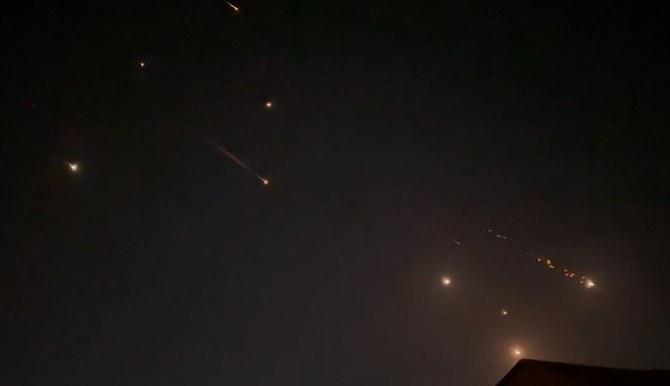Mohamed Chebaro
We know the world’s governance system is splintered. We also know that the rules of warfare have shifted in the last three decades. This is partly due to technological progress, but also due to the parties to conflicts increasingly investing in asymmetric warfare, proxies and “little green men” – agents of chaos and disruption in the name of their paymaster general, whoever that might be.
But what no one imagined is that missile and drone strikes, such as the ones exchanged by Iran and Israel this month, could be prearranged and approved by supposed arch-enemies.
Finely calibrated warfare is what Iran and Israel seem to be embarking on. The question is for how long can this system of warfare potentially achieve the aims of each party without causing larger fires due to a miscalculation?
It is certain that last week’s Israeli strike close to the central Iranian city of Isfahan appears to have caused no significant damage. Although Israel is thought to have struck deep inside Iran before, and as recently as last year in Isfahan, this strike – as “feeble” as it looked – demonstrated an Israeli attempt to keep escalation to a minimum. This is despite the fact the attack was supposed to be a response to Iran’s direct targeting of Israeli territory proper for the first time on April 13, when it fired more than 300 drones and missiles that were largely warded off by Israel’s air defenses.
The fiery rhetoric aside, many in the Middle East have long looked suspiciously at the Israel-Iran relationship, describing it as always on the brink but never escalated to the point where it might harm the strategic interests of the Islamic Republic or its survival, or those in Israel that seek to maintain the country’s supremacy at all costs.
Though Israeli Prime Minister Benjamin Netanyahu has for years made Iran’s nuclear program an electioneering issue, as well as a topic to drum up sympathy with Israel whenever he felt he needed to, this month’s open tit-for-tat exchanges are likely to present his government with new, less comfortable, rules of engagement. Up until recently, it was possible for groups loyal to Tehran to target Israel from Gaza and the West bank, south Lebanon and, less frequently, from Syria. Since Oct. 7, missiles and drones have also been directed toward Israel from as far away as Yemen and Iraq. The deterrence that has been in place – with Israel always having the upper hand in terms of superior capabilities – was questioned by Iran’s April 13 attack.
Iran’s leadership, on the other hand, must feel emboldened, as it is clearly reaping the benefits of its years of investment in militant Arab groups, which have been effective in upholding Tehran’s interests in the region. These groups are involved in activities ranging from rallying the masses to the cause of liberating Palestine to actively recruiting, training and arming militants. Their meddling has undermined the legitimacy and unity of some Arab countries. Lately, weapons arsenals supplied to these groups by Tehran have been used as a potent force. They have rained down conventional missiles and drones, some with state-of-the-art targeting systems, on Iran’s signal, giving Tehran an edge of plausible deniability.
The region and the wider world might be breathing more comfortably after further escalations were avoided due to successful backchannels preapproving the attacks and responses, but one immediate implication of the exchange was the removal, at least temporarily, of the criticism faced by Israel related to its conduct in Gaza. Once again, Netanyahu’s government, with or without the approval of its Western allies, looks free to see through its job of destroying Hamas, even if it means the loss of further innocent Palestinian lives and even more of Gaza being turned to rubble. Peace or even a ceasefire remain elusive despite all the mediators’ efforts.
Iran, for its part, draws comfort from the latest developments because it dared to twist the rules of the game and shift its confrontation with Israel from the shadows, where it had been for decades, into the open. Many in Iran believe that the early signs of a more emboldened regime are reflected in acts such as it clamping down on those opposing it and apprehending more women who defy the mandatory wearing of the hijab.
Across the Arab pro-Palestinian Middle East, one cannot but sense admiration for Iran, even though its missiles and drones failed to reach their targets. This is also despite the fact that, short of this calibrated attack launched directly against Israel, many believe Tehran’s leadership would prefer to leave Hamas to go on fighting until the last civilian in Gaza. Others are not impressed by the apparently rehearsed and choreographed spectacle of Iran and Israel trading blows.
If anything, the tit-for-tat attacks have vindicated the Iranian leadership and propped it up in the eyes of its core supporters inside Iran and across parts of the Arab world. And the Israeli PM, hated by most of his people, seems to have bought himself a bit more time. Meanwhile, the Palestinians in Gaza stare at the rubble of their destroyed homes, with empty stomachs, cheating death amid the continued Israeli military activities.
Preapproved or agreed strikes present warring parties with new options that might prevent escalation and allow them to save face. In this chapter of open confrontation between Iran and Israel, I am minded to believe that the former has succeeded in changing the rules of the game for years to come. This time, Israel came under attack directly from Iran. Next time, it might not be able to rely on the rushed help of its allies, in case it succumbs to more episodes of direct attacks, whether prearranged or not.
Arab News







